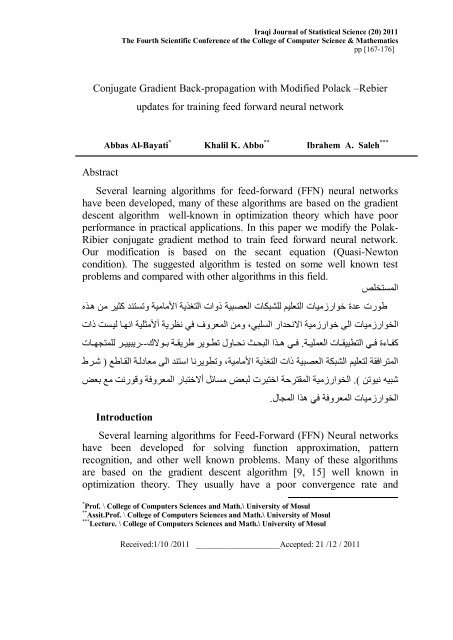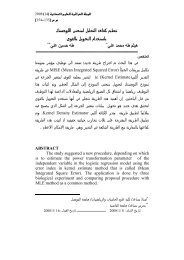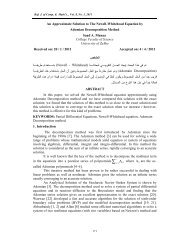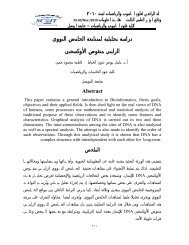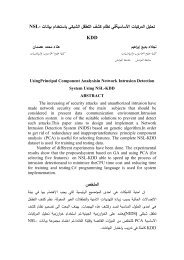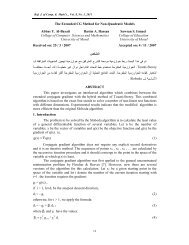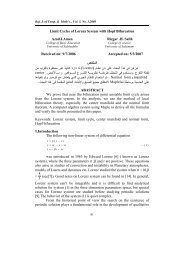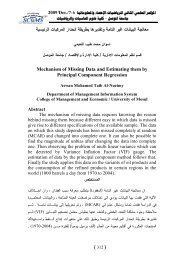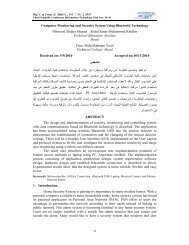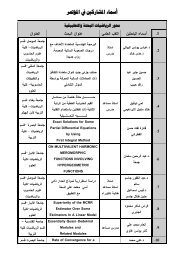Conjugate Gradient Back-propagation with Modified Polack âRebier ...
Conjugate Gradient Back-propagation with Modified Polack âRebier ...
Conjugate Gradient Back-propagation with Modified Polack âRebier ...
You also want an ePaper? Increase the reach of your titles
YUMPU automatically turns print PDFs into web optimized ePapers that Google loves.
Iraqi Journal of Statistical Science (20) 2011<br />
The Fourth Scientific Conference of the College of Computer Science & Mathematics<br />
pp [167-176]<br />
<strong>Conjugate</strong> <strong>Gradient</strong> <strong>Back</strong>-<strong>propagation</strong> <strong>with</strong> <strong>Modified</strong> <strong>Polack</strong> –Rebier<br />
updates for training feed forward neural network<br />
Abbas Al-Bayati * Khalil K. Abbo ** Ibrahem A. Saleh ***<br />
Abstract<br />
Several learning algorithms for feed-forward (FFN) neural networks<br />
have been developed, many of these algorithms are based on the gradient<br />
descent algorithm well-known in optimization theory which have poor<br />
performance in practical applications. In this paper we modify the Polak-<br />
Ribier conjugate gradient method to train feed forward neural network.<br />
Our modification is based on the secant equation (Quasi-Newton<br />
condition). The suggested algorithm is tested on some well known test<br />
problems and compared <strong>with</strong> other algorithms in this field.<br />
المستخلص<br />
طورت عدة خوارزمیات التعلیم للشبكات العصبیة ذوات التغذیة الأمامیة وتستند كثیر من ھذه<br />
الخوارزمیات الى خوارزمیة الانحدار السلبي، ومن المعروف في نظریة ألأمثلیة انھا لیست ذات<br />
كفاءة في التطبیقات العملیة. في ھذا البحث نحاول تطویر طریقة بولاك--ریبییر للمتجھات<br />
المترافقة لتعلیم الشبكة العصبیة ذات التغذیة الأمامیة، وتطویرنا استند الى معادلة القاطع ) شرط<br />
شبیھ نیوتن ).<br />
الخوارزمیة المقترحة اختبرت لبعض مسائل ألاختبار المعروفة وقورنت مع بعض<br />
Introduction<br />
الخوارزمیات المعروفة في ھذا المجال.<br />
Several learning algorithms for Feed-Forward (FFN) Neural networks<br />
have been developed for solving function approximation, pattern<br />
recognition, and other well known problems. Many of these algorithms<br />
are based on the gradient descent algorithm [9, 15] well known in<br />
optimization theory. They usually have a poor convergence rate and<br />
*<br />
Prof. \ College of Computers Sciences and Math.\ University of Mosul<br />
**<br />
Assit.Prof. \ College of Computers Sciences and Math.\ University of Mosul<br />
***<br />
Lecture. \ College of Computers Sciences and Math.\ University of Mosul<br />
Received:1/10 /2011 ____________________Accepted: 21 /12 / 2011
<strong>Conjugate</strong> <strong>Gradient</strong> <strong>Back</strong>-<strong>propagation</strong> With <strong>Modified</strong> <strong>Polack</strong> –Rebier…<br />
depend on parameters which have to be specified by the users, because<br />
no theoretical basis for choosing them exists. The values of these<br />
parameters are often crucial for the success of the algorithm. One of these<br />
algorithms is the standard <strong>Back</strong><strong>propagation</strong> (BP) [14].<br />
Although BP is the most common and widely used supervised<br />
algorithm, nevertheless because of the user depended parameters, it is<br />
usually inefficient on large scale problems.<br />
The neural network training problem can be formulated as a non linear<br />
unconstrained optimization problem. So the training process can be<br />
realized by minimizing the error function E defined by:<br />
Where<br />
n l<br />
E ( w,<br />
b)<br />
= å<br />
(1)<br />
1 l 2<br />
2<br />
( d i<br />
- x i<br />
)<br />
i=<br />
1<br />
l<br />
x is a function of w (the weight vector), b (the bias) and d is the<br />
target through the equations of the forward pass. This cost function<br />
measures the squared error between the desired and actual output vectors.<br />
The general purpose of the training is to search an optimal set of<br />
connection w in the manner that the error of the network output can be<br />
minimized.<br />
The CBP algorithm<br />
Lets diagram the network as<br />
1 1<br />
w , b<br />
2 2<br />
w , b<br />
l l<br />
w b<br />
o<br />
1<br />
l<br />
x ¾¾¾® x ¾¾® ¾ ,................ ¾¾® x<br />
l nl<br />
l<br />
Where x Î R for all l = 0,......... , L and w is an n l<br />
* n l- 1matrix for all<br />
l<br />
l = 1,....,L<br />
, b is the bias for each l = 1,....,<br />
L there are L + 1 layers of<br />
neurons, and L hidden layers, we would like to change the weights w<br />
l<br />
and biases b so that the actual output x becomes closer to the desired<br />
out put d.<br />
The <strong>Back</strong><strong>propagation</strong> algorithm consists of the following steps.<br />
o<br />
1- Forward pass. The input vector x is transformed into the output<br />
l<br />
vector x , by evaluating the equation<br />
x ( k)<br />
=<br />
l<br />
i<br />
f ( u<br />
l<br />
i<br />
) =<br />
f (<br />
nl<br />
1<br />
å -<br />
j=<br />
1<br />
w<br />
l<br />
ij<br />
x<br />
l-1<br />
j<br />
+ b<br />
For l=1 to L, and k is index of iteration usually called epoch<br />
2- Error computation .The difference between the desired output d<br />
L<br />
and actual output x is computed<br />
l<br />
i<br />
)<br />
[168]
The Fourth Scientific Conference of the College of Computer Science & Mathematics<br />
L<br />
L<br />
L<br />
d ( k)<br />
= f ¢ ( u )( d - x )<br />
(2)<br />
i<br />
i i i<br />
3- <strong>Back</strong>ward pass. The error signal at the output units is propagated<br />
<strong>Back</strong>wards through the entire network, by evaluating<br />
nl<br />
l - 1<br />
l -1<br />
l l<br />
d<br />
j<br />
( k)<br />
= f ¢ ( u<br />
j<br />
) åd<br />
i<br />
wij<br />
, from l=L to 1 (3)<br />
i=<br />
1<br />
4- Learning updates. The weights and biases are updated using the<br />
results of the forward and backward passes. Compute the gradient<br />
E<br />
vector g<br />
k<br />
= ÑE(<br />
k)<br />
= and learning rate a and update the<br />
l<br />
k<br />
w ( k)<br />
ij<br />
weights and biases and set d = -g<br />
, a Î(0,0.5)<br />
k k<br />
l<br />
l<br />
w ( k + 1) = w ( k)<br />
+ a d<br />
(4)<br />
ij<br />
ij<br />
k<br />
l<br />
l E<br />
b ( k + 1) = b ( k)<br />
- a<br />
(5)<br />
i<br />
i<br />
l<br />
bi<br />
K=k+1; go to step(1).<br />
We see from step(4) the BP algorithm uses the Steepest Descent (SD)<br />
search direction <strong>with</strong> fixed step-size or (learning rate) a in order to<br />
perform the minimization of the error function E, the iteration form of the<br />
SD algorithm is:<br />
d = -g k k<br />
(6)<br />
w = w + a d<br />
k +1<br />
k<br />
k<br />
k<br />
n<br />
Where k is the current iteration usually called epoch, w 0<br />
Î R is given<br />
initial weight vector, a<br />
k<br />
is learning rate and d<br />
k<br />
= -g<br />
k<br />
for all k and g the<br />
gradient vector of the error function E that is g = ÑE(w)<br />
, E represents the<br />
batch error measure defined as the sum of squared differences error<br />
function over the entire training set.<br />
The inefficiency of SD is due to the fact that the minimization<br />
direction and learning rate are chosen poorly; if the step-size does not<br />
lead directly to the minimum, steepest descent will zig-zag <strong>with</strong> many<br />
small steps[15]. In the literature there have been proposed many<br />
suggestions [3, 4] to define the search direction d k<br />
and most of them use<br />
second order information , for example the Quasi-Newton(QN) methods<br />
are one of the most exploited methods.<br />
The following iterative method can be seen as general QN procedure<br />
to solve the problem(1):<br />
Calculate the search direction<br />
d k<br />
by solving the equation<br />
[169]
<strong>Conjugate</strong> <strong>Gradient</strong> <strong>Back</strong>-<strong>propagation</strong> With <strong>Modified</strong> <strong>Polack</strong> –Rebier…<br />
Then set<br />
d = -H g<br />
(7)<br />
w<br />
k<br />
k<br />
k<br />
k +1<br />
= wk<br />
+ a<br />
k<br />
d<br />
k<br />
(8)<br />
2<br />
-1<br />
where, H<br />
k<br />
is the secant approximation to the inverse ( Ñ E ( wk<br />
)) and<br />
a<br />
k<br />
is updated by line search. The matrix H is usually required to<br />
k<br />
positive definite to ensure a descent direction i.e<br />
g T<br />
< 0<br />
(9)<br />
d k k<br />
H<br />
k<br />
is updated at every iteration to a new inverse Hessian approximation<br />
H<br />
k +1<br />
for which the general QN equation<br />
H y = s<br />
(10<br />
k +1 k k<br />
)<br />
Where sk<br />
= wk<br />
+1<br />
- wk<br />
and yk<br />
= g<br />
k +1<br />
- g<br />
k<br />
, is satisfied [6] . By extending the<br />
secant condition (10),Wei in [17] proposed the modified secant condition<br />
H y =<br />
(11<br />
Where<br />
k +1<br />
s k<br />
)<br />
y = y + A s<br />
(12)<br />
k<br />
k<br />
k<br />
Where Ak<br />
is a simple symmetric and positive matrix.<br />
Despite the theoretical and super linear rate of convergence advantages of<br />
Quasi-Newton methods, the main drawback of these methods is the use of<br />
the inverse Hessian or an approximation to it and this requires more<br />
storage hence not suitable for large-scale problems.<br />
The conjugate gradient method is one choice for solving large scale<br />
problems, because it does not need any matrices [11] or [18], In this work<br />
we will propose a new conjugate gradient algorithm for training feed<br />
forward neural network.<br />
The remainder of this paper is organized as follows, section 2 presents<br />
a brief summary of conjugate gradient. In section 3 the new conjugate<br />
gradient method presented and finally section 4 deal <strong>with</strong> our<br />
experimental results.<br />
[170]
The Fourth Scientific Conference of the College of Computer Science & Mathematics<br />
2- <strong>Conjugate</strong> <strong>Gradient</strong> Methods(CG)<br />
In <strong>Conjugate</strong> gradient methods the basic idea for determining the search<br />
direction d<br />
k<br />
in step(4) Eq.(4) is the linear combination of the negative<br />
gradient at the current iteration <strong>with</strong> the previous search direction namely<br />
d<br />
k + 1<br />
= -g<br />
k + 1<br />
+ b<br />
k<br />
d<br />
k<br />
, d1<br />
= -g1<br />
(13)<br />
In the literature there have been proposed several choices for defining<br />
the scalar parameter b<br />
k<br />
which gives rise to distinct conjugate gradient<br />
methods[16]. The most famous ones were proposed by Fletcher-Reeves<br />
(FR) [7] defined as:<br />
T<br />
FR g<br />
k+1 g<br />
k + 1<br />
b =<br />
(14)<br />
T<br />
g g<br />
k<br />
k<br />
And Polak – Ribiere (PR) [12] written as:<br />
T<br />
PR g<br />
k<br />
y b = + 1 k<br />
T<br />
(15)<br />
g<br />
k<br />
g<br />
k<br />
If the objective function E is strongly convex quadratic, then in theory the<br />
two choices for the update parameter b<br />
k<br />
are equivalent <strong>with</strong> an exact line<br />
search i.e. the learning rate a<br />
k<br />
computed as:<br />
dE(<br />
w + a d )<br />
k<br />
k T<br />
= g<br />
k + 1<br />
d<br />
k<br />
= 0<br />
(16)<br />
da<br />
For non-quadratic cost functions, each choice for b<br />
k<br />
leads to different<br />
performance. Despite the strong convergence theory that has been<br />
FR<br />
developed for the Fletcher-Reeves b , this method is susceptible to<br />
jamming that is to take small steps <strong>with</strong>out making significant progress to<br />
PR<br />
the minimum see [8]. In general, the performance of Polak-Ribiere b is<br />
FR<br />
better than the performance of b method. On the other hand, Powell<br />
showed that [13] <strong>with</strong> an exact line search, PR method could cycle<br />
infinitely, <strong>with</strong>out converging to a stationary point. In summary, the<br />
convergence of the PR method for general non-linear function is<br />
PR<br />
uncertain [8], the reason for this uncertainty is b < 0 in some cases. In<br />
each conjugate gradient(CG) iteration, the step size (learning rate) a<br />
k<br />
is<br />
chosen to yield an approximation minimum for the problem<br />
min 0<br />
E(<br />
w k<br />
a d k<br />
)<br />
(17<br />
a ³<br />
+<br />
)<br />
[171]
<strong>Conjugate</strong> <strong>Gradient</strong> <strong>Back</strong>-<strong>propagation</strong> With <strong>Modified</strong> <strong>Polack</strong> –Rebier…<br />
Since a<br />
k<br />
> 0 , the direction d<br />
k<br />
should satisfy the descent condition<br />
eq.(9) for all k. If there exists a constant c >0 such that<br />
T<br />
2<br />
g d -c<br />
g , c Î(0,1)<br />
(18)<br />
k<br />
k<br />
<<br />
k<br />
For all k, then the search direction satisfies the sufficient descent<br />
condition. The termination conditions for CG line search are often based<br />
on some versions of the Wolfe conditions. The standard Wolfe conditions<br />
[2] are<br />
T<br />
E( w + a d ) - E(<br />
x ) £ da g d<br />
(19)<br />
k<br />
k<br />
k<br />
k<br />
k<br />
k<br />
k<br />
T<br />
T<br />
g<br />
k 1<br />
d<br />
k<br />
³ s g<br />
k<br />
d<br />
(20)<br />
+ k<br />
Where d<br />
k<br />
is descent direction and 0 < d < s < 1 .<br />
3- <strong>Back</strong> <strong>propagation</strong> <strong>with</strong> <strong>Modified</strong> Polak-Ribiere updates<br />
As mentioned in the previews section the main drawback for PR<br />
PR<br />
method is b < 0 in some cases, to overcome this drawback we<br />
incorporate the second other information of the objective function E by<br />
using equations (11) and (12) that is<br />
H y =<br />
(21<br />
k +1<br />
s k<br />
)<br />
2<br />
Where H is an approximation to the inverse Ñ E ( w )<br />
k + 1<br />
k + 1<br />
, and<br />
y = y + A s<br />
(22)<br />
k<br />
k<br />
k<br />
k<br />
Where A<br />
k<br />
is any symmetric and positive definite, since A<br />
k<br />
is symmetric<br />
and positive definite we can take A<br />
k<br />
as diagonal matrix i.e.<br />
= q I<br />
(23)<br />
A<br />
k k n*<br />
n<br />
There exist different values for q ( q > 0) for example we may take<br />
k<br />
k<br />
T<br />
s y<br />
k k<br />
q = , [4]<br />
(24)<br />
k T<br />
s s<br />
k<br />
k<br />
Or<br />
T<br />
sk<br />
sk<br />
q = , g Î[ 0,1] , [1]<br />
(25)<br />
kl T<br />
T<br />
k<br />
s s + g s y<br />
k<br />
k<br />
k<br />
k<br />
k<br />
MPR<br />
Therefor we can modify PR ((<br />
b ) by using equations (11), (18) and<br />
(24) or (25)<br />
[172]
The Fourth Scientific Conference of the College of Computer Science & Mathematics<br />
T<br />
T<br />
T<br />
MPR g<br />
k<br />
+ y<br />
k<br />
g<br />
k + 1<br />
yk<br />
+ q<br />
k<br />
g<br />
k + 1sk<br />
b = =<br />
(26)<br />
T<br />
T<br />
g g g g<br />
k k<br />
k k<br />
Then the new search direction is<br />
d<br />
g<br />
= -<br />
k + 1 k+<br />
1<br />
Where<br />
+ b<br />
MPR<br />
k<br />
d<br />
MPR<br />
b as in equation (26).<br />
k<br />
k<br />
(27)<br />
Then our modified (MPRBP say) algorithm can be written as:<br />
<strong>Modified</strong> PR <strong>Back</strong><strong>propagation</strong> (MPRBP) algorithm<br />
The steps (1), (2) and (3) are same as CBP algorithm and step(4) changes<br />
to the following form<br />
Step(4):<br />
1. Initialization: use Nguyen widrow method to initialize the weights and<br />
l<br />
Biases and set k=1, gaol = err, e > 0 and compute g = ÑE( w ( k)<br />
And E( w<br />
l ( k)),<br />
l = 1,.., L , d = -g<br />
, a<br />
k k k<br />
=1/ g<br />
k<br />
l<br />
2. If E ( w ) err or g < e stop w l ij<br />
( k),<br />
l = 1,..,<br />
L is optimal else goto 3<br />
k<br />
<<br />
k<br />
3. learning rate computation: compute a by line search procedure such<br />
k<br />
that Wolfe conditions (19) and (20) are satisfied and update the<br />
weights and biases according to the<br />
l<br />
l<br />
w ( k + 1) = w ( k)<br />
+ a d<br />
ij<br />
b ( k + 1) = b ( k)<br />
+ a d<br />
l<br />
i<br />
ij<br />
l<br />
i<br />
k<br />
k<br />
k<br />
k<br />
MPR<br />
4. Direction computation: compute , b and set<br />
+ 1 k<br />
MPR<br />
d = -g k<br />
+ b d , if Powell restart is satisfied then set d<br />
+1 k k<br />
k<br />
= -g<br />
+ 1 k+<br />
1<br />
Else d k<br />
= d ; k=k+1 go to 2<br />
+1<br />
g<br />
k<br />
k<br />
ij<br />
3. Experiments and Results:<br />
A computer simulation has been developed to study the performance of<br />
the learning algorithms. The simulations have been carried out using<br />
MATLAB. The performance of the modified Polak-Rebier(MPRBP)has<br />
been evaluated and compared <strong>with</strong> batch versions of BP, constant<br />
learning BP (CBP) , Fletcher-Revees (FR) and Polak-Rebier (PR) these<br />
algorithms known as (traingd), (traincgf) and (traincgp) respectively in<br />
the neural net work toolbox. Toolbox default values for the heuristic<br />
parameters of the above algorithms are used unless stated otherwise. The<br />
[173]
<strong>Conjugate</strong> <strong>Gradient</strong> <strong>Back</strong>-<strong>propagation</strong> With <strong>Modified</strong> <strong>Polack</strong> –Rebier…<br />
algorithms were tested using the same initial weights, initialized by the<br />
Nguyen-Widrow method [11] and received the same sequence of input<br />
patterns. The weights of the network are updated only after the entire set<br />
of patterns to be learned has been presented.<br />
For each of the test problems, a table summarizing the performance of<br />
the algorithms for simulations that reached solution is presented. The<br />
reported parameters are: min the minimum number of epochs, mean the<br />
mean value of epochs, max the maximum number of epochs, Tav the<br />
average of total time and succ. The succeeded simulations out of (100)<br />
trials <strong>with</strong>in the error function evaluations limit.<br />
If an algorithm fails to converge <strong>with</strong>in the above limit, it is considered<br />
that it fails to train the FNN, but its epochs are not included in the statical<br />
analysis of the algorithms, one gradient and one error function<br />
evaluations are necessary at each epoch.<br />
3.1 Problem (1): (SPECT Heart Problem):<br />
This data set contains data instances derived from Cardiac Single<br />
Proton Emission Computed Tomography (SPECT) images from the<br />
university of Colorado [8]. The network architectures for this medical<br />
classification problem consists of one hidden layer <strong>with</strong> 6 neurons and an<br />
output layer of one neuron. The termination criterion is set to E £ 0.1<br />
<strong>with</strong>in limit of 1000 epochs, table(1) summarizes the result of all<br />
algorithms i e for 100 simulations the minimum epoch for each algorithm<br />
is listed in the first column (Min), the maximum epoch for each algorithm<br />
is listed in the second column, third column contains (Tav) the average of<br />
time for 100 simulations and last columns contains the percentage of<br />
succeeds of the algorithms in 100 simulation.<br />
Table(1): Results of simulations for the Heart problem<br />
Algorithms Min Max Mean Tav Succ<br />
CBP<br />
FR<br />
PR<br />
MPRBP <strong>with</strong> [4]<br />
MPRBP <strong>with</strong> [1]<br />
fail -- -- -- 0.0%<br />
31 70 31.870 0.0911 100%<br />
20 56 31.066 0.0701 100%<br />
18 59 31.850 0.0833 100%<br />
21 52 28.860 0.0657 100%<br />
3.2 Problem (2):<br />
Continuous function Approximation:<br />
The second test problem we consider is the approximation of the<br />
continuous trigonometric function:<br />
[174]
The Fourth Scientific Conference of the College of Computer Science & Mathematics<br />
f(x)=sin(x)*cos(3x).<br />
The network architectures for this problem is 1-15-1 FNN (thirty<br />
weights, sixteen biases) is trained to approximate the function f(x), where<br />
x Î [-p,p] and the network is trained until the sum of the squares of the<br />
errors becomes less than the error goal 0.001. The network is based on<br />
hidden neurons of logistic activations <strong>with</strong> biases and on a linear output<br />
neuron <strong>with</strong> bias. Comparative results are shown in table (2). Figure (1)<br />
shows performance of SBP.<br />
Table(2): Results of simulations for the function approximation problem<br />
Algorithms Min Max Mean Tav Succ<br />
CBP<br />
FR<br />
PR<br />
MPRBP <strong>with</strong> [4]<br />
MPRBP <strong>with</strong> [1]<br />
Fail --- --- --- ---<br />
66 292 116.60 0.5229 100%<br />
61 208 115.27 0.4874 100%<br />
66 216 111.13 0.4861 100%<br />
54 149 104.14 0.4660 100%<br />
REFERENCES<br />
[1] Abbo .K. (2007). "Modifying of Barzilai and Borwein Method for<br />
solving large scale unconstrained optimization problem", Iraqi J. of<br />
statical science Vol. 11, No.7.<br />
[2] Andrei N.(2010)"New accelerated conjugate gradient algorithms as a<br />
modification of Dai- Yuan´s Computational scheme for<br />
unconstrained optimization" J. of computational and Applied<br />
Mathematics 234.<br />
[3] Apostolopulou M., Sotiropoulos D., Livieris I and Pintelas . (2009)<br />
'A memoryless BFGS neural network training Algorithm " 7th IEE<br />
International Conference on Industrial Informatics.<br />
[4] Battiti R. (1992)" First and second order methods for learining :<br />
between steepest descent and Newtons method ", Neural<br />
computation(4).<br />
[5] Birgin, E. and Martinez, M. (2001), "A spectral conjugate gradient<br />
method for unconstrained optimization", Applied Math and<br />
Optimization, vol. (43).<br />
[6] Farzin M., Malik H. and Wah J. (2009)," Memoryless <strong>Modified</strong><br />
symmetric Ranlc.One Method for Lerge– Scale Unconstrained<br />
Optimization" Americ Journal of Applied Sciences G(12).<br />
[7] Fletcher, R. and Reeves, G. (1964), "Function minimization by<br />
<strong>Gradient</strong>s". Computer. Journal , Vol. 7.<br />
[175]
<strong>Conjugate</strong> <strong>Gradient</strong> <strong>Back</strong>-<strong>propagation</strong> With <strong>Modified</strong> <strong>Polack</strong> –Rebier…<br />
[8] Hager W. and Zhany H. (2006),"A surrey of non-linear conjugate<br />
gradient methods" Pacific J. Optim.2.<br />
[9] Livieris I., Sotiropoulos D. and Pintelas P. (2009),"On Descent<br />
spectral CG algorithms for Training Recurrent Neural<br />
Network", IEEE Computer Society. 13 th Panhellenic Conference<br />
on Informatics.<br />
[10] Nguyen D. and Widrow B. (1990), "Improving the learning speed<br />
of 2-layer neural network by choosing initial values of the adaptive<br />
weights", IEEE First International Jaint Conference on Neural<br />
Networks 3.<br />
[11] Nocedal J. and Wright S.(1999),"Numerical Optimization"<br />
Springer Verlag, New York.<br />
[12] Polak, E. and Ribiere,G. (1969), " Not sur la convergence de<br />
Directions conjugate". Rev. Franaisse Informants. Research<br />
operational, 3e Anne., 16.<br />
[13] Powell M.D. (1984)," Nonconvex minimization Calculations and<br />
the <strong>Conjugate</strong> <strong>Gradient</strong> Method" Numerical Analysis (Dundee.<br />
1983), Leckux Notes in Mathematics Vol. 1066.<br />
[14] Rumelhart D. and Mcclelland J.(1986),"parallel distributed<br />
processing explorations in the microstructure of Cogniton. Vol.1:<br />
Foundations. MTT press.<br />
[15] Sotiropoulos D., Kostopoulos A. and Grapasa T.(2002)"A spectral<br />
version of perry´s Gonjugate <strong>Gradient</strong> method for Neural Network<br />
Training. 4th GRACM Congress on computational Mechanics.<br />
Vol(1).Patra.<br />
[16] Wei C. and Wang k. (2010),"Global Convergonce of a new<br />
<strong>Conjugate</strong> gradient method for modified liu-Story formula. J. of<br />
East China Normal University No.(1).<br />
[17] Wei Z., Li G. and Qi L. (2006)," New Quasi-Newton methods<br />
for unconstrained optimization problems". J.Applied Math.<br />
Comput., 175.<br />
[18] Yabe H. and Sakaiwa N. (2005)," A New Non-linear <strong>Conjugate</strong><br />
gradient method for unconstrained optimization. J. of the<br />
Operations Research Society of Japan. vol.48. No.4.<br />
[176]


